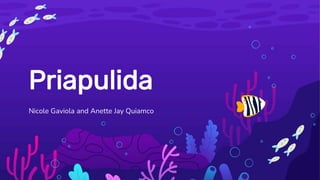Priapulida Report
•Als PPTX, PDF herunterladen•
0 gefällt mir•202 views
Marine Invertebrates found in deep waters
Melden
Teilen
Melden
Teilen

Empfohlen
Weitere ähnliche Inhalte
Was ist angesagt?
Was ist angesagt? (20)
Petromyzon -External features and comparative hagfish

Petromyzon -External features and comparative hagfish
Ähnlich wie Priapulida Report
Ähnlich wie Priapulida Report (20)
0_Presentation of A Coelomate & a Non Coelomate Animal 2.pptx

0_Presentation of A Coelomate & a Non Coelomate Animal 2.pptx
Presentación animales marinos ilustrada azul _20231122_090918_0000.pdf

Presentación animales marinos ilustrada azul _20231122_090918_0000.pdf
Classification of Animals-Seanna Sofiah Santillan.ppt

Classification of Animals-Seanna Sofiah Santillan.ppt
0_Presentation of A Coelomate & a Non Coelomate Animal 2 (1).pptx

0_Presentation of A Coelomate & a Non Coelomate Animal 2 (1).pptx
Kürzlich hochgeladen
Kürzlich hochgeladen (20)
Feature-aligned N-BEATS with Sinkhorn divergence (ICLR '24)

Feature-aligned N-BEATS with Sinkhorn divergence (ICLR '24)
Call Girls Alandi Call Me 7737669865 Budget Friendly No Advance Booking

Call Girls Alandi Call Me 7737669865 Budget Friendly No Advance Booking
Kochi ❤CALL GIRL 84099*07087 ❤CALL GIRLS IN Kochi ESCORT SERVICE❤CALL GIRL

Kochi ❤CALL GIRL 84099*07087 ❤CALL GIRLS IN Kochi ESCORT SERVICE❤CALL GIRL
Hire 💕 9907093804 Hooghly Call Girls Service Call Girls Agency

Hire 💕 9907093804 Hooghly Call Girls Service Call Girls Agency
❤Jammu Kashmir Call Girls 8617697112 Personal Whatsapp Number 💦✅.

❤Jammu Kashmir Call Girls 8617697112 Personal Whatsapp Number 💦✅.
Pests of mustard_Identification_Management_Dr.UPR.pdf

Pests of mustard_Identification_Management_Dr.UPR.pdf
SAMASTIPUR CALL GIRL 7857803690 LOW PRICE ESCORT SERVICE

SAMASTIPUR CALL GIRL 7857803690 LOW PRICE ESCORT SERVICE
Seismic Method Estimate velocity from seismic data.pptx

Seismic Method Estimate velocity from seismic data.pptx
Asymmetry in the atmosphere of the ultra-hot Jupiter WASP-76 b

Asymmetry in the atmosphere of the ultra-hot Jupiter WASP-76 b
Nightside clouds and disequilibrium chemistry on the hot Jupiter WASP-43b

Nightside clouds and disequilibrium chemistry on the hot Jupiter WASP-43b
Priapulida Report
- 1. Priapulida Nicole Gaviola and Anette Jay Quiamco
- 3. The penis worms (Priapulida) are a group of marine invertebrates named for their penis-like shape. All species of the tubular animals, which can reach lengths of 39 cm, have an extensible mouth called a proboscis that is lined with sharp hooks, teeth, and spines. Only 20 species of priapulid are known today, a shadow of their diverse past, which extends back for well over 500 million years. Not commonly seen, the priapulids have attracted little attention from the zoology community as a whole.
- 4. Body Anatomy
- 5. Spines of various sizes and shapes cover the entire surface of the introvert. Inside the introvert is a muscular feeding tube armed with teeth. The animals use a pair of muscles to pull the introvert completely into the trunk.
- 6. The trunk houses the internal body organs, in particular the digestive system and reproductive organs. The body is filled with fluid that serves as a skeleton to support the body when the muscles of the body wall contract. When priapulans move, the fluid moves around in the body cavity and serves the functions of circulation, waste removal, and respiration. The tail is continuous with the body cavity of the trunk and may be used for respiration.
- 7. Diet and Feeding Behaviour Priapulida feed on slow-moving invertebrates, such as polychaete worms.
- 8. With the introvert fully extended, priapulans grasp prey with their teeth and rapidly roll it inward. Priapulans depend on their fluid skeleton for movement. They use their extended introvert and the muscles of the front part of their trunk to anchor themselves in the sand. Once anchored, priapulans can pull themselves through the sand by contracting their body wall muscles.
- 9. Reproduction Priapulans have separate sexes. They release their eggs and sperm into the water, where fertilization, or the uniting of egg and sperm to start development, takes place and larvae develop. Larvae are animals in an early stage that change form before becoming adults.
- 10. Habitat and Distribution Priapulida (Penis Worm) are widespread, living up to 6,000 metres deep in the ocean all the way to the seashore, worldwide.
- 11. Priapulans live in sand and mud in all oceans at all depths. Larger priapulans live in colder waters. Small priapulans are most common in shallow tropical waters. They can live in marine sand and mud in long, U-shaped burrows, but some species also live between rocks.
- 13. Discovery of a Specie Discovered in 1973, is perhaps the most interesting priapulid. Named after the leaders of an ancient Jewish rebel army, Maccabeus is a midget amongst its kind—just 1.4 to 2.8 mm and it lives in a tiny, gelatinous tube in the seabed. What’s really odd about this little animal is the way it catches its prey—smaller animals, such as microscopic crustaceans, etc. Much of the body of Maccabeus is concealed in its tube with the head end lying flush with the sea bed and its crown of spines poking up into the water—forming a trap to snare prey. When an unfortunate animal blunders into this trap, the spines close over to form a cage from which there is no escape. Trapped, the prey is sucked into Maccbeus’ mouth and eaten.
- 14. Distinct Characteristics Although rarely seen by casual observers, priapulids can be very abundant in some places and densities of 85 adults and 58,000 larvae per square meter have been recorded. They even seem to thrive in anoxic sediments (depleted of oxygen) suffused with eggy, highly toxic hydrogen sulphide—a habitat that few other animals can tolerate. Not only can they be surprisingly abundant, but they, and other very poorly known animal lineages, once collectively known as “lesser lineages,” are fundamental to our understanding of animal evolution as a whole, yet we have only scratched the surface of their biology and ecology.
- 15. Thank You